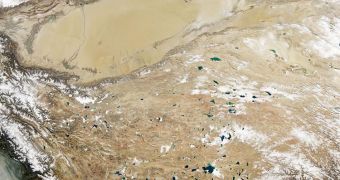A new study led by investigators at the Pennsylvania State University (Penn State) suggests that the Tibetan Plateau may be two to three times older than previously believed. Geologists from around the world contributed to this research.
The investigation primarily focused on the growth of high topography in the Tibetan Plateau near Sichuan, China. Past estimates suggested that geological processes began here between 10 and 15 million years ago.
However, in a paper published in the latest online issue of the top journal Nature Geoscience, scientists argue that high topography at this location actually began forming more than 30 million years ago.
For the study, the team scoured the mountain ranges situated along the eastern edge of the plateau. Their expedition was supported by the Chinese National Key Projects Program, the National Natural Science Foundation of China, and the US National Science Foundation (NSF).
The collision between the Indian and Asian tectonic plates, which gave birth to the Tibetan Plateau and the Himalayan mountain range, began sometime between 55 and 50 million years ago. But scientists say that the landscape at the collision site was not flat to begin with.
“Significant topographic relief existed adjacent to the Sichuan Basin prior to the Indo-Asian collision,” the research group writes in the paper. “Our study suggests that high topography began to develop as early as 30 million years ago, and perhaps was present even earlier,” explains Eric Kirby.
“Most researchers have thought that high topography in eastern Tibet developed during the past 10 to 15 million years, as deep crust beneath the central Tibetan Plateau flowed to the plateau margin, thickening the Earth's crust in this area and causing surface uplift,” the expert adds.
Kirby, an associate professor for geosciences at Penn State, led the work with Erchie Wang, an expert at the Institute of Geology and Geophysics (Chinese Academy of Sciences) and colleague Kevin Furlong, also a geosciences professor.
The team came to its conclusion after studying the decay rate of uranium and thorium, and after conducting fission track dating on samples of the minerals apatite and zircon.
“These methods allow us to investigate the thermal regime from about 250 to about 60 degrees Celsius. The results show that the rocks cooled relatively slowly during the early and mid-Cenozoic – from 30 to 50 million years ago – an indication that topography in the region was undergoing erosion,” Kirby concludes.

 14 DAY TRIAL //
14 DAY TRIAL //